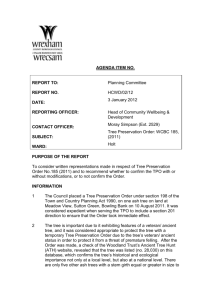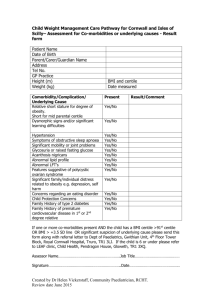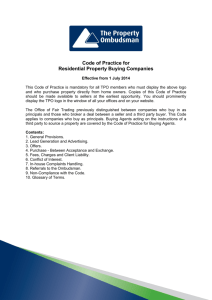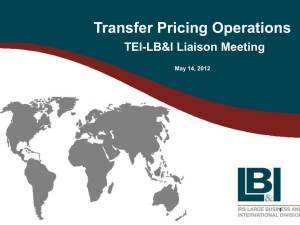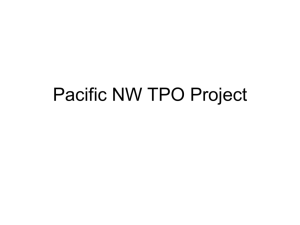the PDF - Clarkston Consulting
advertisement
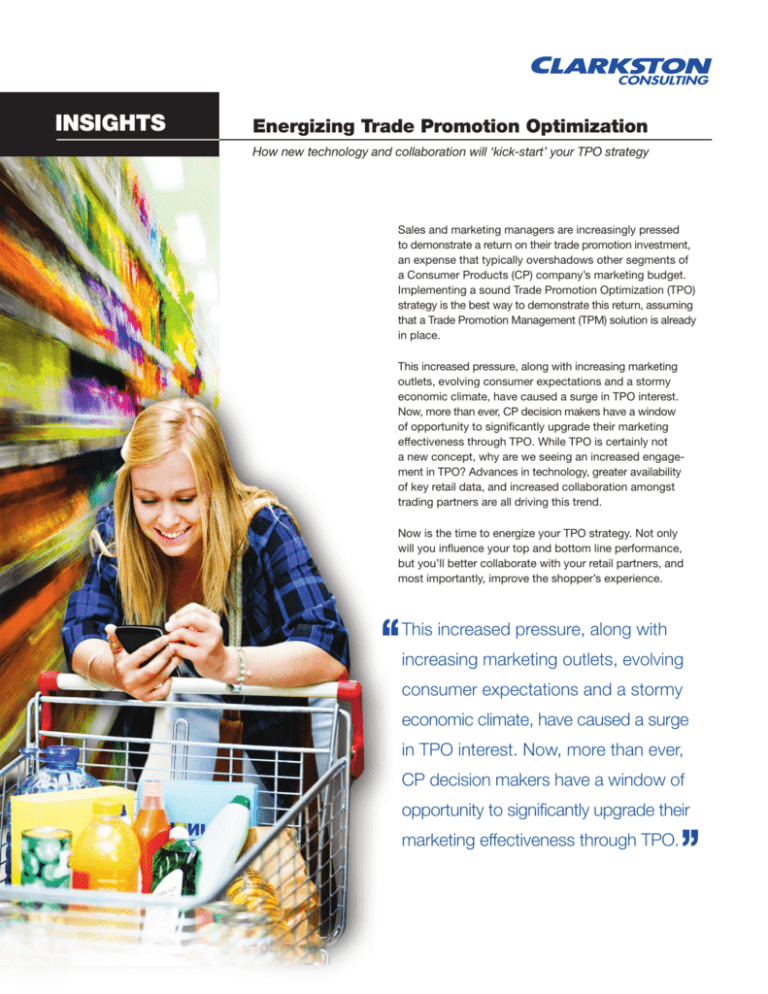
INSIGHTS Energizing Trade Promotion Optimization How new technology and collaboration will ‘kick-start’ your TPO strategy Sales and marketing managers are increasingly pressed to demonstrate a return on their trade promotion investment, an expense that typically overshadows other segments of a Consumer Products (CP) company’s marketing budget. Implementing a sound Trade Promotion Optimization (TPO) strategy is the best way to demonstrate this return, assuming that a Trade Promotion Management (TPM) solution is already in place. This increased pressure, along with increasing marketing outlets, evolving consumer expectations and a stormy economic climate, have caused a surge in TPO interest. Now, more than ever, CP decision makers have a window of opportunity to significantly upgrade their marketing effectiveness through TPO. While TPO is certainly not a new concept, why are we seeing an increased engagement in TPO? Advances in technology, greater availability of key retail data, and increased collaboration amongst trading partners are all driving this trend. Now is the time to energize your TPO strategy. Not only will you influence your top and bottom line performance, but you’ll better collaborate with your retail partners, and most importantly, improve the shopper’s experience. ‘‘ This increased pressure, along with increasing marketing outlets, evolving consumer expectations and a stormy economic climate, have caused a surge in TPO interest. Now, more than ever, CP decision makers have a window of opportunity to significantly upgrade their ’’ marketing effectiveness through TPO. INSIGHTS Trade Promotion Optimization The Growth of Account Planning Additionally, trade spending has grown in marketing mix weight, now encompassing more than 60 percent of the average marketing budget.3 Yet, despite rising investment levels, only 5 percent of companies feel all of their trade promotion objectives are being met.4 To appreciate the urgency of the TPO imperative, it is helpful to start with planning. Manufacturers’ ongoing quest to influence shopper behavior has entrenched their habit of paying significant sums to retailers in return for promotional performance. Each year this practice is reinforced as average spending levels gradually increase. This situation has built up within an environment where manufacturers are pushed to drive sales growth with retail buyers who wanted to purchase product for the lowest possible net cost. Short term spikes in sales could be readily achieved via promotional investment. But challenges in management’s visibility into increasingly complex account plans, time lags between sales plans and actual results, disparate sources of subpar data, and heavy reliance on manual analysis contributed to the promotional planning spiral that is pervasive today. Over time, promotional under-achievement has unfortunately become routine for many. Inferior plans continued to be repeated due to lack of shopper insights and original ideas. In general, serious expectations for positive return on investment have quietly fizzled away, or performance measurement has lacked precision or data history and has therefore often been overlooked or misunderstood. th Sp ur t 30% o w AV E R AG E % of R E V E N U E DEDIC AT ED TO T R A DE Retailers count on this marketing investment, as evidenced by the incorporation of these dollars into their planning budgets and their performance measures. In fact, even with escalating new media alternatives outside of trade promotion, analysts predict unprecedented trade spend growth. In 2020, the percent of revenue manufacturers will spend on trade promotions is expected to approach 30 percent.1 Gr 18% Time for Change Gro w th S Fortunately, advances in technology and improved access to high-quality, timely data have caught up with the concept of TPO. Companies now have an opportunity to make realistic gains in promotion effectiveness and forecasting accuracy versus merely hoping results will turn around by trying harder using their current tools and capabilities. t 10% p ur 5% 1980s 1990s Today 2020 TIME This encouraging news has gained momentum and brought renewed awareness to those who recognize a need to change. Sales and marketing leaders responsible for building brand equity and growing profitable sales have been hit by a recent wave of attention regarding TPO. Not surprisingly, consultants and software vendors have readily offered scholarly, but sometimes confusing, opinions as to what TPO means and what the industry should be doing with it. Gap Between Spend and Return A recent Acosta Sales and Marketing study found that 56 percent of CP companies reported that trade investment was their highest or second highest priority for increased spending over the next three years.2 The continued growth is fueled by factors such as the rise in shopper marketing programs, discounts to offset inflation, and promotions to compete with private label brands. Clarkston Consulting www.clarkstonconsulting.com 2 For more information, email us at info@clarkstonconsulting.com INSIGHTS Trade Promotion Optimization It makes sense to work on improving those marketing decisions that can have the most immediate impact on sales, volume, and profit. This is not to suggest that MMO should be ignored. On the contrary, it is to be embarked upon by gaining energy from embracing TPO. Then once TPO is mastered, comprehensive MMO can be realistically attained. TPO enables quicker understanding of the scenarios that shoppers want most. Modeling and analytics tools speed up testing and learning. Price responsiveness and margin guesswork can be eliminated. Promotion frequency and inventory positions can be optimized. Merchandising vehicles can be localized cost-effectively to reduce waste. Shopper messaging can be crisp and relevant. TPO is on the cusp of becoming a competitive necessity, with four central points: Most notable is the retailer’s appreciation of the manufacturer’s capabilities to provide innovative ideas. This appreciation has drawn retailers towards those partners that can accurately predict and deliver mutual value propositions. Trusted manufacturers will now experience more objective planning and review sessions and tighter promotional execution compliance. 1.TPO is the means to break out of account planning doldrums. It helps manufacturers and retailers speak the same financial language of investment and return. It enables them to provide shoppers superior shopping experiences based on continual learning through modeling and analysis. Retailers appreciate fresh insights and the ability to innovate and grow with timely data. On top of trade promotions, marketers also face growing investment decisions around additional marketing tools, such as websites, search engine optimization, e-commerce, application ads, mobile advertising, and social media, as well as the traditional TV, print, price, and packaging. This increasing complexity indicates all the more the need to get the one line item that stands out the most on P&L statements – trade expenditures – done right. 2.Powerful TPO software is available and distinctions in technology choices are more intelligible which can help expedite buying decisions. 3.Data is foundational for advanced modeling. TPM data and demand history that has been accumulating can be increasingly utilized in predictive modeling. 4.Economic principles must be applied to support tradeoff decisions where the pace of change in marketing and media choices is escalating. TPO provides logic and direction as to which combination of marketing options will drive competitive advantages in sales, profit, and market share. How We Define TPO Trade Promotion Optimization is the use of predictive modeling techniques and analytics to identify the best combination of promotional investment variables (mainly price, merchandising, and timing) within a set of constraints to achieve an incremental sales return. Components include: a strategic plan, repeatable processes, organizational structure, tools, and analytics. First Things First In working with many of the leading companies in the CP industry, we realize most organizations have adopted TPM systems over the last 15 years. They have improved their ability to store account plans in one place, to manage settlements and deductions, to aggregate annual plans, to estimate trade exposure, and to look at account promotional history. But shopping habits and marketing strategy are ever changing. Shoppers are agnostic to retail channels; they’re online, they’re mobile, and they’re informed. They expect convenient, personalized solutions, discernible product options, and information at their fingertips. Selling and marketing to them requires focused communications and savvy placement of marketing bets accompanied by continuous analysis. Walk, Then Run The same climate within the CP industry that has caused the surge in TPO has also caused increased interest in Marketing Mix Optimization (MMO). Astute manufacturers and retailers recognize that TPO efficiently delivers actionable insights to improve their ability to have a relevant dialogue with shoppers. Clarkston Consulting www.clarkstonconsulting.com 3 For more information, email us at info@clarkstonconsulting.com INSIGHTS Trade Promotion Optimization TPO is the next step necessary to effectively compete, providing an immediate and lasting impact on the single biggest lever within your marketing portfolio. In our view, the first step is to evaluate the merits of TPO on impacting your marketing investments and business in general. Of course, full MMO should be the ultimate goal, but MMO is multipart and can take considerable time to make meaningful progress. TPO is the largest component of marketing mix and it is showing no signs of shrinking. Now is the time to take advantage of the latest developments in TPO and attain quantifiable results that largely appeared elusive. About the Author Bill Schamp is a director with Clarkston Consulting. He has over 20 years of industry and management consulting experience in North America and abroad. He has helped executives shape and execute business strategies to yield improvements in the areas of integrated business planning including trade promotion optimization, customer and shopper marketing, marketing investment, and category management. References A Guide to Improving Manufacturer/Retailer Collaboration for Promotional Activities, Gartner. January 2010. 1 The Trend Behind the Spend. Acosta Sales and Marketing. Accessed at http://www.acosta.com/Marketing_Solutions/Category_Mgmt___Adv__ Analytical_Svcs.aspx 2 Nielsen Wire. April 2010. Accessed at http://blog.nielsen.com/nielsenwire/ consumer/six-trade-promotion-tips-why-less-can-be-more 3 Romanow, K. Analyzing Trade Promotions: Does A Solution Exist? Consumer Goods Technology. April 2011. 4 CASE STUDY Challenge Operating in a highly competitive market, this leading food company’s profitability relies heavily on effectively spending their trade dollars. As their trade investment levels rose steadily ahead of sales revenue, our client needed to improve the accuracy of their sales forecasting and manage their sales resources more efficiently. Solution Clarkston implemented an end-to-end collaborative annual trade planning process using Oracle’s Demantra predictive software. Beginning with designing the solution in a ‘Design Lab’, Clarkston enabled our client to take advantage of an integrated collection of demand data to conduct more robust analytics and better predict their demand curve. The solution also utilizes a Demand Signal Repository (DSR) to harmonize and cleanse demand data originating from disparate sources to feed the new trade system. Results With this new TPO solution, our client is able to feed customer demand data into a new comprehensive predictive trade planning tool. Within the tool they are able to forecast their sales broken out into base and incremental sales from their growing understanding of promotional sales lifts. Their sales and marketing teams are now able to simulate promotion scenarios and make informed investment decisions up front as opposed to repeating past trade practices and selling to customers without the benefit of reasonably understanding ROI in advance. About Clarkston Consulting Clarkston Consulting is a different kind of management and technology consulting firm. We deliver a unique experience for market leaders within the Consumer Products and Life Sciences industries. Considering professionalism, expertise, and value as prerequisites, we take service a step further through our unyielding commitment to the success of people as individuals, both our clients and our employees. By combining integrity, adaptability, and a whatever-it-takes attitude, we have achieved an extremely high rate of referral and repeat business and a 10-year average client 651_0512 satisfaction rating of 97%. For more information, email us at info@clarkstonconsulting.com
